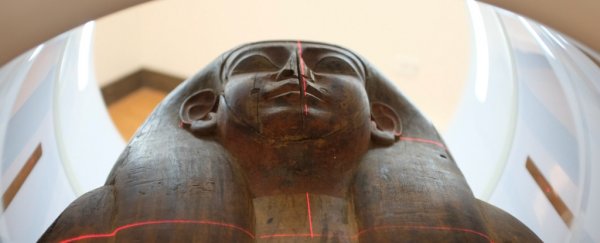For over 150 years, an 'empty' coffin lay at a university museum in Australia. So archaeologists got quite the surprise when last June they discovered mummified human remains inside this 2,500-year-old Egyptian relic.
The coffin belongs to the University of Sydney, and researchers are now working to figure out whose remains they've had on their hands this whole time.
Originally, the sarcophagus was purchased in Egypt by Sir Charles Nicholson. When he served as the university's chancellor, along with this coffin he also donated a range of privately collected artefacts, thus starting off the university's Nicholson Museum of antiquities in 1860.
In recent years, the coffin had been on display, protected by a perspex case in the Nicholson Museum's Education Room. Unlike two other vibrantly painted Egyptian coffins in the collection, this carved wooden one looked quite plain in comparison.
Hieroglyphs on the lid indicate that the sarcophagus was intended to entomb a noblewoman named Mer-Neith-it-es, who served as a priestess at the temple of the lioness-headed goddess Sekhmet, around 664-535 BCE.
 Inside the coffin. (Nicholson Museum)
Inside the coffin. (Nicholson Museum)
"In his 1948 Handbook to the Nicholson Museum, Professor of Archaeology Dale Trendall listed the coffin as empty, although the museum database notes that it contains 'mixed debris'," wrote investigation lead Jamie Fraser for the university's Muse Magazine.
"We had no idea what this would comprise, as the coffin had not been opened for 20 years, but presumably not very much, given Trendall's comments and the coffin's unremarkable presence in the Nicholson collection since its accession 160 years ago."
There was indeed debris in the sarcophagus - as well as human remains, a mix of bones, bandages and faience beads. The bones were a piled jumble mixed in with bandages, and chunks of the resin that was poured over the body as a preserving agent.
Clearly this was the body of someone important - but whether it is Mer-Neith-it-es is another matter. According to the ABC, antiquities dealers back in the day would often sell empty coffins, furnishing them with a mummy if the buyer wished - which wasn't necessarily the mummy the coffin came with.
To help unravel the mystery, the research team used a computed tomography (CT) scanner on their findings. Although they have yet to sift through the remains and piece them together - that process could take months or years - the scan has already provided some intriguing details.
 The mummy's toes, revealed by the CT scan. (Macquarie Medical Imaging)
The mummy's toes, revealed by the CT scan. (Macquarie Medical Imaging)
"While the remains inside the Mer-Neith-it-es coffin were indeed mixed, the scanner detected two mummified ankles, feet and toes, consistent with a single person; the fused ends of some of the bones suggest the person was at least 30 years old," Fraser said.
Inside the coffin, they also found something amazing - the resin that had been poured into the mummy's skull after the brain had been removed, similar to the resin that had been poured into the skull of the famous pharaoh Tutankhamun.
"It could tell us so much," egyptologist Connie Lord told the ABC. "It's just an incredible find, I don't remember anyone finding something like this. It would have to be incredibly rare."
The coffin, along with three others owned by the museum - Meruah, Horus and Padiashiakhet - will be going on display at the Mummy Room in the new Chau Chak Wing Museum at the university, due to open in 2020. They will be accompanied by digital CT animations showing the remains inside.
